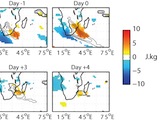Clémence Macron PhD thesis
 Les talwegs tropicaux-tempérés en Afrique australe : mécanismes et évolution face au changement climatique
Les talwegs tropicaux-tempérés en Afrique australe : mécanismes et évolution face au changement climatique
Defended on the 1st July 2014
Funding: doctoral grant
Supervisors : Yves Richard and Benjamin Pohl
Started in October 2010
Abstract
Southern African and Southwest Indian Ocean sector is one of the three preferred zones of the Southern Hemisphere of interactions between the tropics and midlatitudes.. It is the so-called South Indian Convergence where form synoptic systems characterized by northwest-southeast orientated bands of clouds: Tropical-Temperate Troughs (TTTs). TTTs are seen as an interaction between a tropical disturbance in the lower layers and a mid-latitude westerly wave in the upper atmosphere and are responsible for significant amounts of rainfall during austral summer. Despite many studies, the physical mechanism involving both tropical convection and mid-latitude transient perturbations to influence the development and variability of TTTs in time and space are still not well understood.
The first part of the thesis aims at (i) understand the physical mechanisms linking mid-latitude transients and tropical convection; (ii) document the contribution of TTTs to seasonal rainfall in South Africa. The second part studies the long term evolution of such systems (frequency, persistence; changes in spatial patterns…) and of their contribution to precipitation in southern Africa. The 40-yr European Centre for Medium-Range Weather Forecasts reanalysis (ERA-40) are used to favorable background conditions leading to the genesis and development of a Tropical-Temperate Trough (TTT) over Southern Africa (SA) / the Southwest Indian Ocean (SWIO) during the austral summer season. The accuracy of TTT simulations together with expected future changes are presented using eight available CMIP5/AR5 ESMs under the RCP2.5 and 8.5 emission scenarios.
Keywords
Southern Africa and Southwest Indian Ocean, Tropical-temperate-troughs, atmospheric dynamics, rainfall, climate change
- extrait:
- lien_externe:
- kc_data:
- a:8:{i:0;s:0:"";s:4:"mode";s:0:"";s:3:"css";s:0:"";s:9:"max_width";s:0:"";s:7:"classes";s:0:"";s:9:"thumbnail";s:0:"";s:9:"collapsed";s:0:"";s:9:"optimized";s:0:"";}
- kc_raw_content:
 Les talwegs tropicaux-tempérés en Afrique australe : mécanismes et évolution face au changement climatique
Les talwegs tropicaux-tempérés en Afrique australe : mécanismes et évolution face au changement climatiqueDefended on the 1st July 2014
Funding: doctoral grant
Supervisors : Yves Richard and Benjamin Pohl
Started in October 2010
Abstract
Southern African and Southwest Indian Ocean sector is one of the three preferred zones of the Southern Hemisphere of interactions between the tropics and midlatitudes.. It is the so-called South Indian Convergence where form synoptic systems characterized by northwest-southeast orientated bands of clouds: Tropical-Temperate Troughs (TTTs). TTTs are seen as an interaction between a tropical disturbance in the lower layers and a mid-latitude westerly wave in the upper atmosphere and are responsible for significant amounts of rainfall during austral summer. Despite many studies, the physical mechanism involving both tropical convection and mid-latitude transient perturbations to influence the development and variability of TTTs in time and space are still not well understood.
The first part of the thesis aims at (i) understand the physical mechanisms linking mid-latitude transients and tropical convection; (ii) document the contribution of TTTs to seasonal rainfall in South Africa. The second part studies the long term evolution of such systems (frequency, persistence; changes in spatial patterns...) and of their contribution to precipitation in southern Africa. The 40-yr European Centre for Medium-Range Weather Forecasts reanalysis (ERA-40) are used to favorable background conditions leading to the genesis and development of a Tropical-Temperate Trough (TTT) over Southern Africa (SA) / the Southwest Indian Ocean (SWIO) during the austral summer season. The accuracy of TTT simulations together with expected future changes are presented using eight available CMIP5/AR5 ESMs under the RCP2.5 and 8.5 emission scenarios.
Keywords
Southern Africa and Southwest Indian Ocean, Tropical-temperate-troughs, atmospheric dynamics, rainfall, climate change
